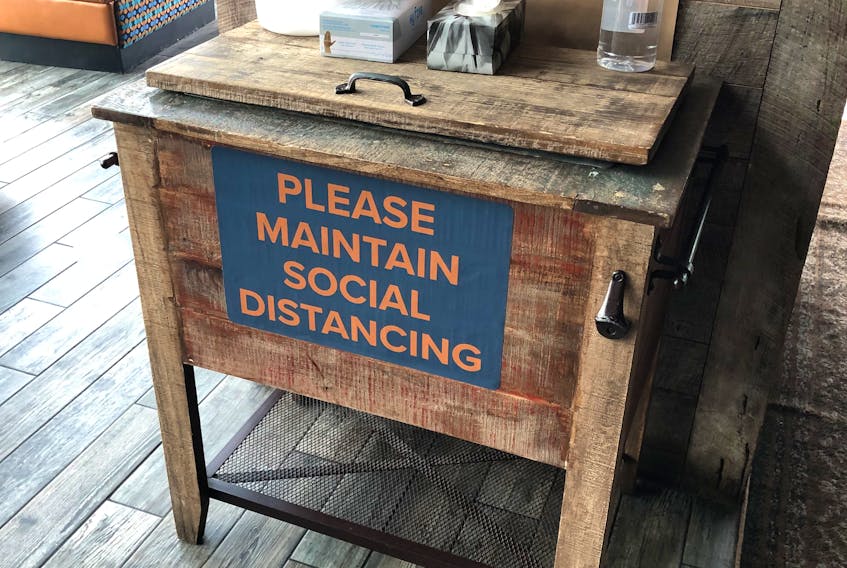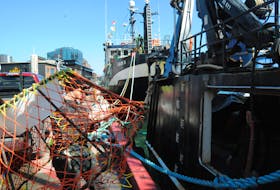It’s been a long, hard journey for restaurants since March.
St. John’s Fish Exchange in downtown St. John’s, N.L., has been operating evening service at a 50 per cent capacity due to health requirements. The business has removed tables and chairs to encourage social distancing and put up signage throughout the restaurant to show proper flow of guest traffic as part of COVID-19 measures. All staff are wearing masks and, if they are feeling unwell at all, they are not to work, says co-owner Justin Garland.
“Instead of serving 150 guests, we can serve 75,” says Garland. “Also, we are not sitting (people) at our bar, which is another 16 guests lost at the moment.”
For Big Burger, located in both the Charlottetown mall and the Founder’s Food Hall on the waterfront, there are lots of signs and floor signs directing people, as well as social distancing awareness signs and notices outline the time limit that people are allowed to sit. Hand sanitizer stations are at all entrances and exits, and there is an added barrier at the cash locations.
“Our working space is not very spacious so we must also practice social distancing between employees, so it's hard to move around like usual,” says Big Burger chief executive officer Charbel Jreij.
This is the new normal that restaurants must adapt to and try to survive in a COVID-19 world.
Small profit margins, big hit
“The restaurant industry around the world has been devastated,” says Nicole Robinson, who is in the faculty of business and tourism at the NSCC Kingstec campus in Kentville, N.S.
The restaurant industry has some of the smallest profit margins of any kind of business. Closing their doors for an indefinite period would have made the most stoic owner take a deep breath, she says. Many of these restaurants also have overhead in rent or mortgages, staffing, fixed costs and astronomical costs in equipment payments.
To stay afloat during quarantine closures, Robinson says many restaurants were able to pivot and find alternate ways to service their customers and keep some employees working. Whether they served take out, pre-made meal kits or offered a delivery service, they were able to keep the doors open.
And, with restrictions lifting, albeit with heavy guidelines in place, operations are having to continue creatively. Nova Scotia restaurants, for instance, are now allowed to operate at full capacity, but must ensure patrons are able to maintain social distancing. This means that some restaurants still can’t operate at full capacity.
“I believe that the restaurants that survive are the ones who have taken the last few months and really thought hard about what they can do and looked at best practices around the world,” says Robinson.
Communities across the province are modifying street traffic so restaurants can put patios out and still maintain safe distances. In Fredericton, the Delta Hotel has come up with a creative solution, says Robinson: the business is hosting a drive-in, where customers pay for a ticket that includes menu items from its new barbecue restaurant.
Geoff Hopgood, owner of Juniper Food and Wine in Wolfville, N.S., normally a 16-seat facility, says, in addition to the prepared foods they offer, they are about to launch a fried chicken pop-up on the weekends.
“We are doing this because we are so small that we need to adapt to more of a takeout restaurant with a front patio on the sidewalk,” he says. “We thought it would be a fun concept to try for the summer. Our choices are limited.”
Although they’ve reduced the seating indoors to respect the 2m distance between tables, Hopgood says luckily, the town of Wolfville was great about expediting a ‘sidewalk cafe’ patio permit for them. With the indoor and outdoor seating combined, Hopgood says they should have around 20 seats total, more than what they would have had just indoors.
“And now we’ll hopefully be playing catch-up for the lost revenue from being closed!” he says.
To help save local restaurants, Robinson says, it’s imperative that we support them.
“We do this by not just going out to eat,” she says.
Locals really need to understand that these small businesses were the ones who, for years, have been supporting our local fundraisers and sports teams, Robinson said. Now it’s time to give back.
“Share the heck out of a restaurant meal on social media, write them a great review, take awesome food shots, write shout-outs to the owners and servers for taking such good and safe care of you. We all can do that, and it doesn’t take much,” says Robinson.
Tough competition
Getting customers can be challenging with all the current competition. It’s a balancing act to do all you can to drum up intertest and have promotions, Garland says.
“I see some stuff out there and say I know that’s just giving the house away and pushing other businesses to slash prices in order to keep up without realizing everyone is just driving each other out of business,” he says.
Garland also explains that online delivery services like Skip the Dishes or Door Dashes, although they provide another way of getting your product out, are just sending any potential profit out the door as well.
Now that it's summer, the competition increases a lot, with food trucks and seasonal restaurants popping up all over, Jreij adds.
In the end, some restaurants likely won’t make it.
The majority of the profits for the year are made during the summer season, when tourists are plenty and locals are dining out before heading to summer events. This extra summer revenue is used to weather the difficult winter months, says Garland.
“We are still receiving great support from our local customer base but without the tourist and business trade, it eliminates the shoulder period revenue that summer usually brings,” says Garland.
Jreij agrees, saying that tourism this year is taking a huge hit. There were over 100 cruise ships scheduled to visit PEI this summer and fall, not to mention the 1.6 million visitors last year. Pre-COVID, the expectation was even higher numbers of tourists for 2020, he says.
The Atlantic Canada bubble will “help a little,” Jreij believes, calling it “vital for our survival.”
Continued support from governments is an important factor, Garland adds, saying that extending the wage and rent subsidy programs is essential. The high cost of rent, especially in the downtown and shopping centre areas, is crippling to businesses operating with 50 per cent or more in sales lost, he says.
Hopgood also says prices would have to go up substantially in restaurants for any chance of survival of operating at pre-COVID levels.
“Prices of supplies are constantly increasing, but I don't feel that we can increase our own prices. We have to be careful how customers will react to this,” says Jreij.
New normal
Robinson says it’s important for customers to be understanding as restaurants begin to navigate the new normal.
“Many have to make up lost profits just to keep afloat – so please be respectful of higher prices, many had to do some construction to their spaces, lay-off staff, increase sanitization costs, etc.,” she says.
And try not to be afraid.
A lot of the public are scarred from COVID-19, says Hopgood, and likely won’t go back to regular dining until the word is that its as safe as it was before COVID.
“I’m not too sure that will happen,” he says.
It’s important to note, says Robinson, restaurants are taking safety very seriously and have the some of the strictest guidelines to follow to keep patrons safe.
“So, feel safe and enjoy going out to your favorite place and enjoy a meal prepared by folks who are thinking only of serving you great food as safely as they can,” she says.
Going forward, Hopgood says restaurants are having to write a whole new business plan in order to follow protocols to survive.
More research is needed into whether plexiglass and masks make any difference, and what happens with air conditioning units pumping air around, says Hopgood. Other countries have asked residents to maintain one metre of social distancing, instead of the required two metres in Canada, he points out, noting this would help restaurants a lot.
The restaurant industry is not for the faint of heart, it is a 24/7 commitment and certainly takes a tole on family and personal life, says Garland.
“I am so excited to slowly getting back, and the support from our regulars and loyalty and encouragement from my staff has been so empowering it makes you want to fight through this challenging period,” says Garland.









